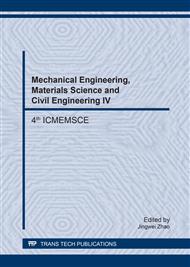p.345
p.350
p.354
p.363
p.369
p.375
p.380
p.384
p.389
The Measurement of SVOC Emission Rates from Building Materials
Abstract:
Recent studies have reported that indoor house dust contains a large volume of SVOC chemical substances such as phthalates. This study measured the SVOC emission rate from various types of building materials and conducted quantitative and qualitative analyses on the emitted substances. DBP and DEHP were detected in all building materials based on the result obtained from measuring the building materials produced in Japan, South Korea, and China. The DBP and DEHP emission rates (95 percentile) from the building materials used for the measurement in this study were 2.56 [μg/m2・h] and 11.63[μg/m2・h] respectively. Larger DBP and DEHP emission rate from building materials are believed to be the reason why a high level of DBP and DEHP is detected in house dust found in residential homes compared to other substances.
Info:
Periodical:
Pages:
369-374
Citation:
Online since:
March 2017
Authors:
Keywords:
Price:
Сopyright:
© 2017 Trans Tech Publications Ltd. All Rights Reserved
Share:
Citation:


